Training Police Tracking Dogs - Tracking Through Drive vs. Foot Step Tracking
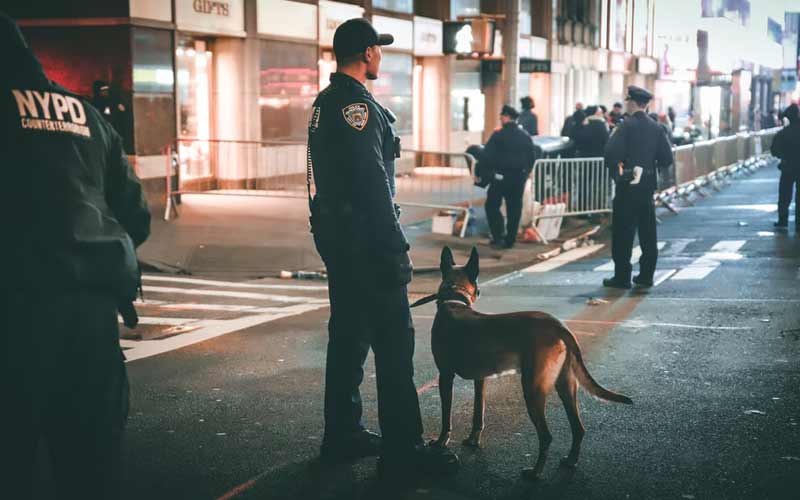
There are two different training styles being practiced in North America to train police tracking dogs. The first is called "Foot Step Tracking" (FST), and the second is called "Tracking Through Drive" (TTD). The vast majority of American police service dogs (99.9%) are trained in FST. This article will explain to the reader why I believe TTD is more productive. It will also explain why FST is so widely used in America.
Let me explain what FST is. This is the style of tracking used in the sport of Schutzhund, or in the WPO DPO Police Dog Certifications. This training is done using food that is dropped along a 400- to 800-yard track. There is usually a ball left at the end of the track that's used as an additional motivator. The dog is expected to track at a slow walk and stay within a couple of feet of the actual footsteps of the tracklayer. This is a very precise form of tracking but also a very slow method of tracking.
If you are a canine handler whose dog is trained in FST, you already know that your "tracking find ratio" on actual suspects is less than 5%. Notice that I said, "track find ratio" and not "area search find ratio." These are two different exercises. The difference is that a track is done on line with the dog following the path that the suspect takes no matter what the wind direction. An area search, on the other hand, is usually done off leash and into the wind. The handler gets downwind of the suspect and works back into the wind until his dog picks up scent. At that point, the dog works the scent cone which leads to the suspect. The dog should always be trained to track before it is trained in area searches. If there is an option to either track or do an area search, tracking is the preferred method to locate people.
If a K-9 officer and his FST partner arrives on scene just minutes after a suspect has escaped through a perimeter, the officer will never catch the bad guy by tracking unless the suspect goes to ground within 1,000 yards. FST tracking dogs simply cannot track fast enough to make up enough distance to catch someone that keeps moving.
It is also physically impossible to expect a foot step tracking dog to follow a 3- to 5-mile long track. This style of work takes too much concentration on the dog's part. The dogs begin to peter out at about 1,000 yards, long before they have traveled even a fraction of most rural tracks.
If you are a canine handler whose dog is trained in TTD, you know that your overall find ratio on tracks is close to 50% and that if the suspect is loose in a rural area and stays rural, your find ratio goes up over 90%. TTD is an entirely different training concept. In TTD, the dog is allowed to follow its natural instincts and run along a track. The handler runs behind on leash.
The concept of TTD training is to expect the dog to overshoot the corners because he is moving with such speed. Even though a dog can smell scent for a long way past a corner (in many cases 50 to 100 yards past the corner), he is trained to give a "negative" when he is 20 feet past the corner.
A "negative" is an indication of track loss. The most common form of a negative takes place when the dog is running along with his nose to the ground and all of a sudden, the nose comes up off the ground and the dog begins to circle.
When the handler sees the dog give a "negative," his job is to get the dog back on the track as quickly as possible. He can either circle the dog to cut the next leg of the track and continue on, or the handler can back up along the track to a point where the dog actually had scent and then help his dog locate the turn.
The motivator for TTD comes from the very first day of training there is always a person at the end of the track. When a dog gets out of a squad and gets into his tracking harness, he knows for sure there is someone out there for him to find. His motivator is the possibility of a fight at the end of the track.
Notice that I said "the possibility" of a fight. This does not mean that the dog is allowed to get a bite on every training track. It does mean that there will always be someone at the end of the track and occasionally that person will fight with the dog. This possibility of a fight is what keeps the tough dogs going when a lesser dog will tire and quit.
TTD was developed by the Royal Canadian Mounted Police (RCMP). Since 1935, TTD is the only training method the RCMP has used at their Police Dog Training Center in Alberta. Over the past 18 months, I have spent 3 1/2 weeks at their school filming TTD tracking. After producing three training videos on this subject, I have become a convert. If a police department is serious about increasing the effectiveness of their canine unit, they need to learn TTD.
In 1993, on my first trip to Alberta, the instructors took me out and showed me a young dog in Level I training (there are three Levels to certify at before graduating). We followed a 5 KM unknown track in the country that was 45 minutes old. The dog tracked at a dead run. This dog has been at the school for about 6 weeks and had 54 training tracks. There were 5 or 6 road crossings, 4 articles, a dead end where the tracklayer doubled back and jumped off to one side, and more corners than I could count. I was only able to keep up with the handler for the first third of the track. In 35 years of dog training, I had never seen anything like this. I was an instant believer.
In 1994, on my second trip to Alberta, I saw a number of dogs in Level III training follow 1.5-mile, 25-minute-old, unknown tracks right through residential neighborhoods during the middle of the day. These tracks went down alleys where dogs were barking behind fences and the dog tracked right past them. I saw dogs flush cats, track right by garbage cans, ignore dog waste in the yards, and track through groups of kids playing in back yards. These dogs still had a month of training left before they certified out of Level III and graduated from the school. I could not believe it.
So while there is no question that TTD has a 58-year proven track record that produces 10 times the results that FST produces, TTD faces an uphill battle to become the accepted training style here in America. The main reason for this is the police dog vendors that supply departments with handler training and dogs.
I have to say that before I went to Canada, I was in the FST boat along with everyone else. I thought FST was the "only" way to train a police tracking dog. I took a 25-page outline on an FST tracking video with me to Alberta on my first trip and threw it in the garbage the night I saw the 5 KM track.
The problem vendors face is that they have traditionally supplied imported dogs with either Schutzhund style training or dogs with the Dutch KNPV training. Both of these dog sports have inherent flaws in them that result in the dogs not being able to deal with TTD.
To begin with, I believe that Schutzhund is a great dog sport, but it is FST. It is also not uncommon for Schutzhund trainers in Europe to "force track" their dogs. Force tracking takes the drive right out of a dog. Once force tracked, a dog will never be trained in TTD. At the very least, the amount of restraint placed on a dog in Schutzhund or WPO tracking restricts the dog to the point where an inexperienced handler will probably not be able to train the dog in TTD. The RCMP has not been able to take a Schutzhund titled dog and retrain it in TTD.
KNPV, on the other hand, is a Dutch sport that does not have any tracking at all, but it does have an area search exercise in the woods. This creates another problem: a dog trained in building search and/or area search before it is trained to track will almost never be able to be trained in TTD. The RCMP has also never certified a KNPV-trained dog at their school.
So not only are service dog vendors faced with a learning process on this new style of tracking, they are also faced with coming up with a new source of dogs for departments that want to get involved in TTD. This is going to be difficult because this work takes an extraordinary dog. What works best is actually finding young dogs from all working bloodlines with no training but a lot of socializing. These dogs not only require good defensive drive (which can be difficult to spot at that young age), they also have to have a really strong prey drive, the kind of prey drive that we want to see in our narcotics dogs.
If a vendor wants to train dogs that will certify in Level III tracking, he must be prepared to put 100 to 120 tracks on a dog. This is an awful lot of time and work. I have a great deal of respect for a vendor that would put this kind of work into dogs that he sells. I will tell you one thing, departments are not going to be buying dogs for $7,000 and getting 8 weeks of handler training and a Level III certified dog. No vendor can afford to put that kind of work into a dog and then sell it for so little money. If they do, they will not be in business very long.
I believe we will begin to see a few vendors offering these dogs, but the price is going to be above the $10,000 range. I also think we will see departments going out and buying young selection tested dogs and doing the tracking (and maybe the training) themselves. The bottom line is that a young, untitled dog with no training is cheaper than a titled import. But a word of caution on selection testing: it is called "buyer beware." We are looking for extraordinary dogs. The RCMP goes through an average of three dogs for every handler that graduates from the school. Maybe this will be the subject of a future article.
What I think will happen in this country is the development of a few really good tracking teams at various departments in each state. These will be highly motivated teams with great dogs that will build their reputation through their find ratios. When something serious happens in other localities, these teams will be requested by neighboring departments.
This is the direction that tracking has taken in Europe. The basic patrol dog coming out of police dog school is trained in FST to pass a WPO, DPO, or PSP certification. When something really serious happens, they don't call for the basic dog. They have their special dogs that are called out. These are their super tracking dogs. In Canada, every RCMP dog (and there are only 110 of them), is a super tracking dog. It's not uncommon for an RCMP handler to have to drive 150 to 200 miles and then track and catch a felony suspect. It happens every day in Canada. With work, it could be happening here in the States.




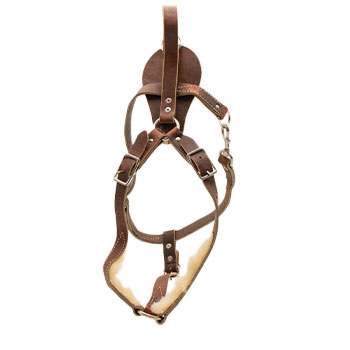
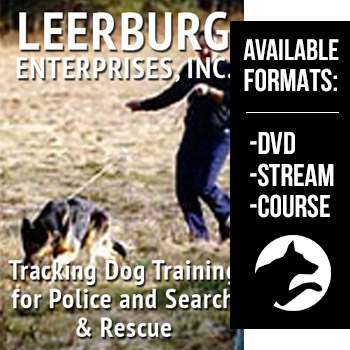

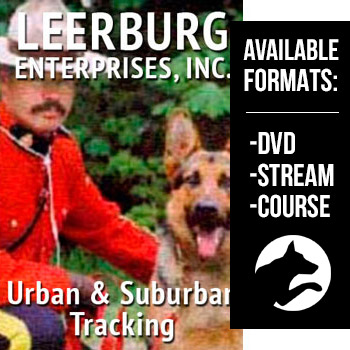


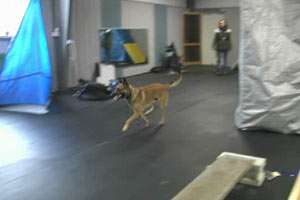
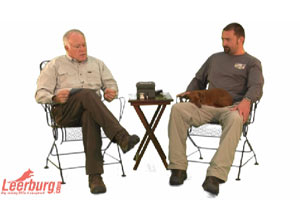
Ask Cindy.